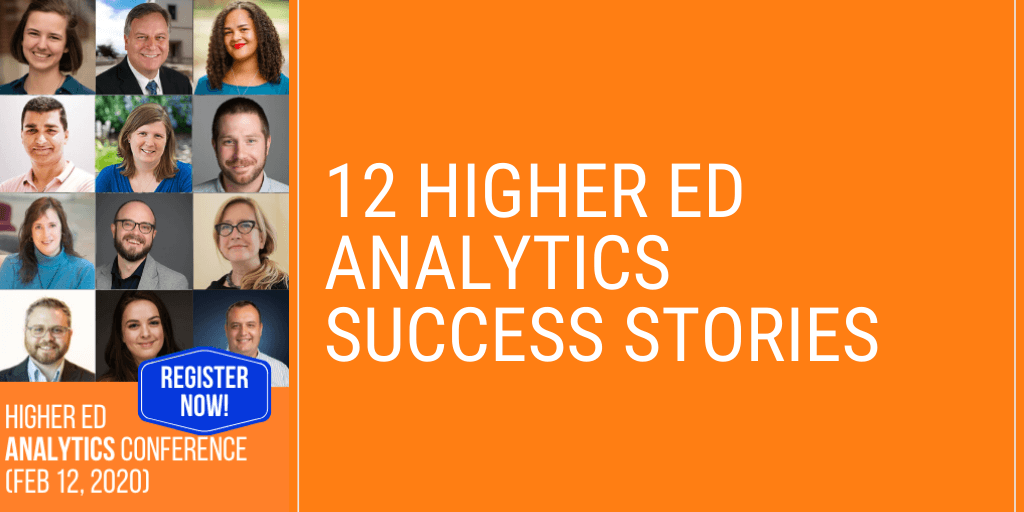Success breeds success.
So, it’s always a great idea to get inspired by success stories from your peers, especially when it comes to digital analytics and measurement strategy in higher education.
That’s why the 12 higher ed speakers of the 2020 Higher Ed Analytics Conference to share with us one of their biggest analytics success story.
Developing an academic program feasibility framework for Avinash Tripathi (Kaplan Higher Education)
 According to the Department of Labor, more than 6.5 million jobs in the US remain unfilled because employers can’t find workers with the necessary skills. We recently developed a program feasibility framework tying the career outcome to the degree program to identify opportunities that may help bridge the workforce supply and demand (skills) mismatch.
According to the Department of Labor, more than 6.5 million jobs in the US remain unfilled because employers can’t find workers with the necessary skills. We recently developed a program feasibility framework tying the career outcome to the degree program to identify opportunities that may help bridge the workforce supply and demand (skills) mismatch.
The framework takes into account various key measures/metrics (Google keyword search trend, IPEDS, Career services, forecast models, Income to debt ratio, etc.) to come up with a scorecard to help academic team with the decision-making.
Using data to change admissions criteria for Dr. Nicholas Ladany (USD)
 The best example was the use of data analytics to seriously examine admissions criteria.
The best example was the use of data analytics to seriously examine admissions criteria.
In particular, we looked at how standardized test scores predicted the efficacy of students who were graduating with a professional degree. We found that the standardized test scores were inversely related to performance and as a result, we dropped that particular test from our admissions process.
Revamping academic department websites for Elicia Dennis (University of Notre Dame)
 Within our college, we found that prospective graduate students use department websites to research programs ahead of applying. Repeated visits during the period between acceptance and decision suggest that many prospective students also return to the same website when determining which university they ultimately want to attend.
Within our college, we found that prospective graduate students use department websites to research programs ahead of applying. Repeated visits during the period between acceptance and decision suggest that many prospective students also return to the same website when determining which university they ultimately want to attend.
Last year, one of our campus partners surveyed admitted graduate students who were accepted to the university but opted not to attend to find out what influenced their decision. One of the most common reasons given was that there was insufficient information about career development support. Since our analytics show that graduate students rely on our department websites for part of their decision-making process, those websites were the first step in addressing the recruitment problem we identified.
We inventoried the career information across our graduate web pages and have begun to update those sites with more robust lists of career resources. We will continue working with our other campus partners to re-evaluate the effectiveness of improving our career-centered content through this next graduate student recruitment season.
Optimizing the lead-gen budget with predictive analytics for Joshua Dodson (VisionPoint Marketing)
 After running a recruitment marketing campaign for a while, we were able to use data on spend by marketing channels and leads to create a predictive model that enabled us to see how we could make specific budget changes and get a lot more leads for the same amount of money.
After running a recruitment marketing campaign for a while, we were able to use data on spend by marketing channels and leads to create a predictive model that enabled us to see how we could make specific budget changes and get a lot more leads for the same amount of money.
This enabled us to make better recommendations and decisions for implementing the best media mix possible. This is a powerful technique to use when you need results with a limited budget. It is important, though, to keep in mind that you have to have historical data to make this type of analysis work.
Optimizing the RFI form for Kris Hardy (Messiah College)
 During a recent project, I was working with the enrollment team to optimize their portion of the website. Knowing that there was likely an abandonment issue on the RFI form due to the number of fields, I wanted to run some tests.
During a recent project, I was working with the enrollment team to optimize their portion of the website. Knowing that there was likely an abandonment issue on the RFI form due to the number of fields, I wanted to run some tests.
I started by tracking the completion rate of the current form, it had a 41% completion rate. The enrollment team was hesitant to remove any fields, so we agreed to run a test for 60 days and temporarily remove a number of the fields. During the test period, the completion rate jumped up to 64%. That ended up resulting in about 77 additional inquiries each month. After providing the data the admissions team agreed to permanently remove the additional fields.
Measuring the impact of news stories for Tatjana Salcedo (University of Vermont)
 We’ve struggled to show the impact of news content our communications office generates on attracting students.
We’ve struggled to show the impact of news content our communications office generates on attracting students.
To address this we’ve added buttons to select news stories to our inquiry form and added event tracking. We’re now gaining valuable insight on which kinds of stories encourage prospective students to engage with us.
Transforming the mobile experience for Mandee Englert (Penn State University)
 This year, we focused a significant amount of time on refreshing the look and feel of our University news website. The engagement on the site was low, we had a high bounce rate from marketing channels driving to the site, and users were unlikely to scroll through an entire article.
This year, we focused a significant amount of time on refreshing the look and feel of our University news website. The engagement on the site was low, we had a high bounce rate from marketing channels driving to the site, and users were unlikely to scroll through an entire article.
When working in Google Analytics, heatmaps and performing some basic user testing, we were able to find that users were overwhelmed with the amount of information that we were providing on the pages as we provided several links to related articles and exposure to all of the tags that were related to each article. Especially from mobile devices, it was a stressful user experience to simply read an article.
We worked with our internal design team and explained the areas that users were experiencing friction on the site. We ran user tests against our hypotheses and made changes to the site. Then, we were able to prove that — with simple changes to our font styling, sizing, column layout and some significant changes to our global navigation on mobile devices — our pages/session, time on site, scroll rate, return users and engagement rates increased significantly.
Implementing self-serve analytics dashboards for Orion Stavre (WPI)
 The biggest win at my school has been the implementation of self-serve data dashboards.
The biggest win at my school has been the implementation of self-serve data dashboards.
Being in a STEM-focused University, not only the Faculty, but also the administration is very data driven. As I came on board and we started becoming more sophisticated on how we looked at our data, our team was inundated daily by requests for data and information. Additionally, we created a new website where the content is managed in a decentralized way. This allowed departments to make independent decisions on what content to use on their websites. But they all needed intelligence on how this content and their sites were performing. We were spending a large part of our time setting up to capture data, build reports, share and educate the team on how to consume the reports and then continually updating these reports.
With the introduction of Google Data Studio that all changed. We created data tracking across the website that could allow us to track all interactions across the website and then be able from the data to identify where the interaction happen. This way we were able to create a uniquely robust database of interactions and the used filters on data studio to build self-serve dashboards for each department. After a few training sessions most departments were able to understand and use their dashboard, and we were mostly focused on more specific ad hoc analyses, rather than just providing data.
Giving campaigns reports for Emily Gustafson (Cornell University)
 We’re currently finishing up a simple way to automatically break down demographic and giving data for a specific audience. This means we can spend less time measuring KPIs and create definitions for success in all of our engagement campaigns. By creating simple reporting techniques, we can empower event planners and marketers to incorporate these standards and insights throughout every step of a campaign.
We’re currently finishing up a simple way to automatically break down demographic and giving data for a specific audience. This means we can spend less time measuring KPIs and create definitions for success in all of our engagement campaigns. By creating simple reporting techniques, we can empower event planners and marketers to incorporate these standards and insights throughout every step of a campaign.
Increasing paid social media budget for Aaron Baker (Harvard University)
 My biggest win this past year was securing more paid social funding as a direct result of data from a recent campaign.
My biggest win this past year was securing more paid social funding as a direct result of data from a recent campaign.
In the past our paid social budget was pretty small, so when we’d boost posts, we’d only use about $25 at a time. Recently we launched a microsite with student, faculty, and alum stories from all over the United States and used these small paid social boosts to make sure people in the areas we were writing about actually saw the content.
A small budget meant we had to be hyper-local with targeting. The traffic wasn’t huge, but the engagement was impressive. We used the data to make the case for a bigger paid social budget for the rest of our project and got the funding!
Revamping the paid campaign measurement framework for Laura Montgomery (The New School)
 For paid advertising, there had been very inconsistent ways of measuring the performance of campaigns that ran across multiple platforms and publishers.
For paid advertising, there had been very inconsistent ways of measuring the performance of campaigns that ran across multiple platforms and publishers.
I was able to renovate our Google Analytics account, establish definitive “conversion” goals, and introduce UTM tagging on every digital tactic we spent money on in order to create a centralized, systematic dashboard reflecting real-time, apples-to-apples performance data.
Focusing on metrics that matter for Corynn Myers (University of Michigan)
 In 2018, the University of Michigan deployed the “This is Michigan” campaign, a multifaceted effort to dispel myths about higher education within the state of Michigan.
In 2018, the University of Michigan deployed the “This is Michigan” campaign, a multifaceted effort to dispel myths about higher education within the state of Michigan.
An agency was tasked with the paid media strategy as other U-M teams took on the earned and owned strategies. Long story short, the campaign was brought in-house and re-strategized through the lens of the business goals we wanted to achieve.
While the agency reported on video views, we really wanted the campaign to focus on multiple metrics that showed us we were building brand advocacy. We thought through what key performance indicators really would get us to that goal and how we could achieve more through paid media and data analysis.
Ultimately, the strategy was revamped and we’ve seen a 30%-increase in metrics across the board including video retention rates, time on site, social shares and more.
A conference focusing on higher ed analytics?
The 2020 Higher Ed Analytics Conference (#HEA20) is a must-attend event for higher ed marketing professionals and teams looking for inspiration, ideas and best practices to step up their analytics and measurement game in 2020
Read below what your higher ed colleagues who attended the past editions of the Higher Ed Analytics Conference said about their experience.
Tags: HEA20, Higher Ed News, Karine Joly